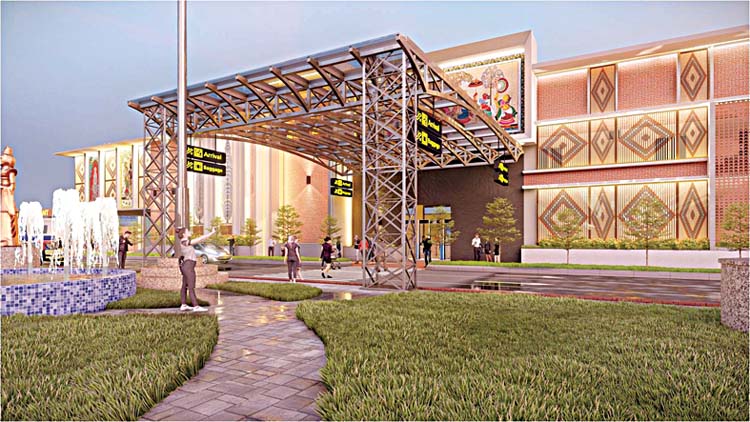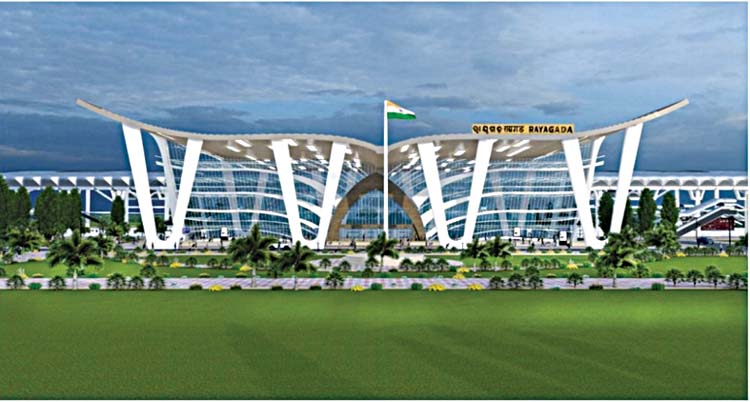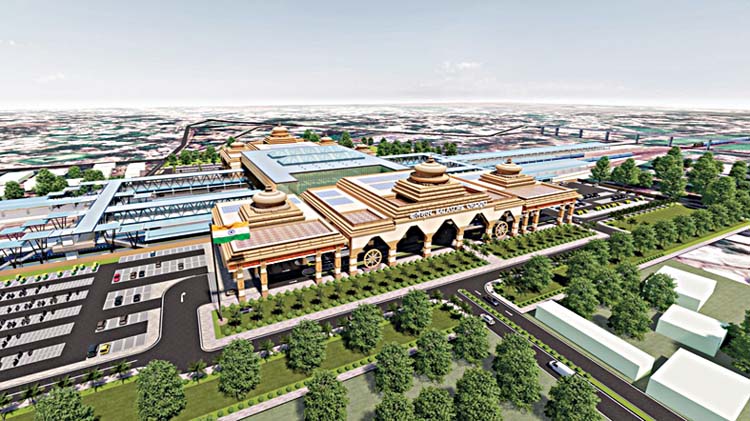These 57 Stations are _ Angul, Badampahar, Balangir, Balasore, Balugaon, Barbil, Bargarh Road, Baripada, Barpali, Belpahar, Betnoti, Bhadrak, Bhawanipatna, Bhubaneswar, Bimlagarh, Brahmapur, Brajrajnagar, Chatrapur, Cuttack, Damanjodi, Dhenkanal, Gunupur, Harishanker Road, Hirakud, Jajpur-Keonjhar road, Jaleswar, Jaroli, Jeypore, Jharsuguda, Jharsuguda Road, Kantabanji, Kendujhargarh, Kesinga, Khariar Road, Khurda road, Koraput, Lingaraj Temple Road, Mancheswar, Meramandali, Muniguda, New Bhubaneswar, Panposh, Paradeep, Parlakhemundi, Puri, Raghunathpur, Rairakhol, Rairangpur, Rajgangpur, Rayagada, Rourkela, Sakhi Gopal, Sambalpur, Sambalpur city, Talcher, Talcher Road, Titlagarh Jn. In the first phase, works for some Major Stations have already been started since last year. 25 Railway Stations have already been selected for the redevelopment works. These Stations are Sakhigopal, Mancheswar, Dhenkanal, Chhatrapur, Angul, Rajgangpur, Meramandali, Balugaon, Lingaraj Temple Road, Talcher Road, Khurda Road, Kantabanji, Bargarh Road, Hirakud, Rairakhol, Barpali, Muniguda, Balangir, Harisankar Road, Jaleswar, Bhawanipatna, Khariar Road, Barbil, Baripada and Damanjodi Stations. Hon’ble Prime Minister of India Shri Narendra Modi Ji laid the foundation Stone for the redevelopment of Stations under Amrit Bharat Scheme, through video conferencing from New Delhi, where, 25 above Stations in Odisha were included.

Now PM Modi is going to laid foundation stone of 21 more stations in Odisha that includes Talcher, Raghunathpur, Paradeep, Kendujhargarh, Jharsuguda Road, Sambalpur City, Titlagarh, Kesinga, Paralakhemundi, Koraput, Jeypore, Bimlagarh, Jaroli, Rairangpur, Panposh, Balasore, Betnoti, Bhadrak, Belpahar, Brajrajnagar and Rayagada stations. In last 10 years, altogether 409 Road Over Bridges (ROBs) and Road Under Bridges (RUBs) in Odisha have already been constructed and work for construction of 220 ROBs/RUBs in the State are in progress. Railways have long been an essential part of the global transportation network, facilitating the movement of people and goods across vast distances with efficiency and reliability. From the early steam locomotives of the 19th century to the sleek semi high-speed trains of today, railways have continually evolved to meet the changing needs of society. In this article, we’ll explore the significance of railways in the modern world, examining their impact on economies, the environment, and the daily lives of people around the globe.
The Economic Backbone: Railways serve as the economic backbone of many nations, facilitating trade and commerce on a massive scale. By providing a cost-effective means of transporting goods over long distances, railways play a crucial role in supply chains, connecting manufacturers, distributors, and consumers across vast geographical regions. In addition to freight transportation, railways also support industries such as tourism and agriculture, providing essential links to remote areas and tourist destinations. Transformation in Indian Railways has been ongoing, with various initiatives aimed at modernizing infrastructure and improving efficiency. The concept of “Amrit Stations” refers to the development of stations with modern amenities and enhanced facilities to provide a better experience for passengers. These stations typically offer improved waiting areas, cleanliness, signage, and other passenger-centric features. Road Over Bridges (ROBs) and Road Under Bridges (RUBs) are critical components of railway infrastructure aimed at eliminating level crossings and improving safety at railway-road intersections. These bridges allow road traffic to pass over or under railway tracks, thereby reducing the risk of accidents and enhancing the flow of both rail and road traffic.
Railway stations in India have been an integral part of memories of almost every individual of the nation. They also are vital symbol of not only the state of infrastructure and transport cum travel logistics of the nation but an important element of visual architectural landscape of the country. Millions of Indians traverse through Indian stations each day, yet never before such an effort, as being done now, was put in place to modernize this essential part of Indian infrastructure and improve day to day travel experience of millions of its people. As India takes determined steps towards multi trillion-dollar economy, mission of transformation of Railways stations, from being an accumulator of dirt, squalor and filth to being the clean bustling centers of comfortable travel, symbol of national pride and heritage and world class conveniences, is truly a remarkable. The mission is already beginning to show astonishing results. These modernized Railway Stations are representative of a nation that is not only modernizing fast but also governance that cares for its citizens. Experiencing Indian Railways means experiencing India as a nation as well.

Before 2014, in the name of modernization, scattered efforts were being made to improve passenger amenities and improve the façade of very few busy Railway stations, with no visibility. After 2014, redevelopment of railway stations across India became a priority agenda of Ministry of Railway. This agenda is now being driven with full force by the Government. Gandhinagar Railway station in Gujarat was the first station to undergo modernization in 2021. Later on, in the same year, Rani Kamlapati Railway Station (formerly known as Habibganj) was the first railway station on Indian Railways being redeveloped. In 2022, Union Cabinet approved redevelopment of 3 major railway stations- New Delhi Railway Station, Ahmedabad Railway Station and Chhatrapati Shivaji Maharaj Terminus (CSMT) Mumbai, with an approximate total investment of nearly Rs.10,000 Cr. The Centre has now drawn out an ambitious plan for transforming more than 1300 railway stations in the country as ‘Amrit Stations’. The mission got a fillip, when in August 2023, Hon’ble Prime Minister, Shri Narendra Modi laid the foundation stone for the redevelopment of 508 Railway Stations across the country. Being redeveloped at a cost of more than Rs 24,470 crores, these 508 stations are spread across 27 states and union territories, including 55 each in Uttar Pradesh and Rajasthan, 49 in Bihar, 44 in Maharashtra, 37 in West Bengal, 34 in Madhya Pradesh, 32 in Assam, 25 in Odisha, 22 in Punjab, 21 each in Gujarat and Telangana, 20 in Jharkhand, 18 each in Andhra Pradesh and Tamil Nadu, 15 in Haryana, 13 in Karnataka among others.
Results that are being seen today, are an outcome of series of efforts and management initiatives being undertaken especially since 2019.Railway Minister Ashwini Vaishnaw has gone on record saying “Our Prime Minister has a huge vision for station redevelopment. When we went with the original designs, he didn’t approve the designs. He told us to design the stations for 50 years ahead. So, we went back to the drawing board, redesigned the entire thing, and then started the construction. So, today we are doing the world’s largest station redevelopment program. 1309 stations are getting redeveloped”.
Development/redevelopment of Railway Stations is complex in nature, involving safety of passengers & trains and requires various statutory clearances such as fire clearance, heritage, tree cutting, airport clearance etc. The progress also gets affected due to brown field related challenges such as shifting of utilities, infringements, operation of trains without hindering passenger movement, restrictions due to works carried out in close proximity of high voltage power lines etc. Wide spread consultations with Urban/Local Bodies and other stakeholders, experts, officers are being done for clearances required from concerned authorities for station development work.
Modernisation of over 1300 Railway Stations is a colossal task and an all-inclusive thorough process has gone behind scientific redevelopment of these stations with speed and scale. The designing has been done in a holistic manner with discussions at the various levels before issuing tenders. Moreover, a standard tender document was curated and shared with all so as to ensure completion of work in a time bound manner. Indian Railways merged the Indian Railway Stations Development Corporation for optimization of redevelopment work. Various top domain experts, Architects and piling agencies were empanelled for suitable use by all divisions and zonal offices. Creation of Gatishakti Directorates in the Zones and Headquarter, besides training of over 9000 personnel for this, has also facilitated in streamlining and speeding up of the processes. The scheme involves preparation of Master Plans and their implementation in phases to improve the amenities at the stations like improvement of station access, circulating areas, waiting halls, toilets, lift/escalators as necessary, cleanliness, free WiFi, kiosks for local products through schemes like ‘One Station One Product”, better passenger information systems, executive lounges, nominated spaces for business meetings, landscaping etc. keeping in view the necessity at each such station.
The scheme also envisages improvement of building, integrating the station with both sides of the city, multimodal integration and amenities for Divyangjans, sustainable and environment friendly solutions. Every station will have a spacious roof plaza with all passenger amenities at one place along with spaces for retail, cafeterias and recreational facilities. Master plan has been prepared for smooth movement of traffic, with adequate parking facilities and efforts would be there to ensure its integration with other modes of transportation like metro, bus etc. Green Building Techniques will be used, with solar energy, water conservation/recycling and improved tree cover. There will be segregation of arrival/departures, Clutter free platforms, improved surfaces, fully covered platforms. Unprecedented transformation of Indian Railway Stations is going to make every Indian proud and every tourist marvel at the pace the change that has taken place.

